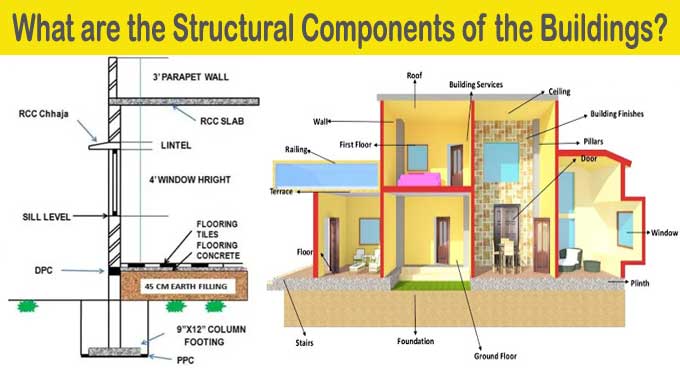NEWS | SOFTWARE | SHEET
Main Components of a Building Structure
The essential parts of a building structure are: floors, foundations, beams, walls, columns, staircases, roofs; those components cater to the objective of assisting, surrounding, as well as safeguarding the building structure.
Furthermore, the building is a structure built for several purposes, every part is utilized or aside from human occupancy or habitation planned to enclose a space or land as well as outside display structures.
Function of a Building
- Buildings cater to various requirements of society such as protection from the weather, safety, living area, store the important things, as well as securely live as well as work.
- A building like a accommodation signifies a physical part of human occupancy or habitation.
List of Building Components
1. Foundation: Foundation is essential to uniformly spread the whole building load upon the soil in this way that no detrimental settlements occur. Therefore, the foundations have to be built on suitable/robust ground.
2. Plinth: Plinth is generally built simply over the ground level as well as directly following the foundation. Furthermore, it lifts the floor over the ground level and hereby averts surface water from getting into the building.
3. Damp Proof Course (DPC): Damp proof course is basically a layer of waterproofing material like waterproof cement or asphalt. Walls are built over the damp proof course. Damp proof course averts surface water from increasing into the walls.
Dampness decreases the strength of the walls as well as makes harmful living environment.
Even it influences the paint as well as plaster and increases the maintenance cost. Damp proofing layer isn’t needed where a plinth beam is built, as the plinth beam just acts like a DPC.
4. Plinth Beam: A plinth beam is built as per the sort of the structure of the building as well as kind of the soil. Furthermore, it offers more stability with respect to settlements of the building as well as earthquake damages.
5. Floor: That is the surface upon which majority of the operations are done. Floorings are placed above the filling of the plinth as well as on following floors.
Flooring can be carried out using various materials, however attention should be provided that the ground underneath the floor is properly compacted. Moreover, flooring is carried out to avert dampness from growing towards the top as well as to possess a strong floor that can be maintained clean as well as good.
6. Walls: Walls are basically the vertical components upon which the roof ultimately lies. They can be made from various materials such as stones, bricks, concrete blocks, mud, lateritic blocks, and so forth. In case the walls are quite long, columns can be offered to hold the roof.
Walls offer concealment as well as fencing. Walls even offer safety as well as safeguard against physical elements like rain, wind as well as sunlight.
Openings are to be offered in wall with regards to access as well as ventilation.
7. Openings: Openings are generally offered in the walls like windows, door as well as ventilators.
Doors offer access; Windows as well as ventilators offer lighting as well as airing.
Lintels are built simply over the openings. It is generally a concrete slab or a stone slab. Sill is the segment of the wall that is simply underneath the window.
Lintels are built to support the walls over the openings. Furthermore, in earthquake prone regions, a continuous lintel beam is offered around the walls.
8. Stairs: A stair is a series of steps as well as it is offered to present the medium of ascension as well as descending amid the floors as well as landings.
The room or apartment of a building whereupon stair is situated is known as staircase. Moreover, the opening or space taken by the stair is known as a stairway.
There are various sorts of stairs, utilized in buildings, such as wooden stair, RCC stair, brick stair, metal stair, and so forth.
To get more clear ideas, go through the following exclusive construction video tutorial.
Lecturer: WIT Solapur - Professional Learning Community
9. Roof: Roof offers security for the building as well as the people residing in it. Moreover, the roof lies on the walls as well as needs appropriate anchoring in order that wind and additional mechanical shock or impact cannot devastate it. Furthermore, a roof can have various forms however it is always either sloping or flat.
Roof is usually made from tiles, RCC, stone slab, and so forth.
10. Finishes / Surfaces: Exterior finishes are the exterior layer of protection, which safeguards the structure from eroding or weathering. Interior finishes are the layers provided on interior faces. Furthermore, they provide stability as well as beautiful look to the interior.
Recommended Articles:
Major Parts of Reinforced Concrete Buildings - Framed Structures Components


